|
9
|
Daibenkudoku-ten
Photo: Scanned from Sanjūsangendō catalog.
Wood Statue.
Height = 164 cm.
Kamakura Period.
National Treasure.
|
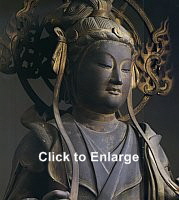 大弁功徳天 (だいべんくどくてん) 大弁功徳天 (だいべんくどくてん)
Considered a manifestation of Benzaiten by some, but by others of Kichijōten 吉祥天 (Skt. = Śrī-devī, Lakṣmī, Laksm), the Buddhist goddess of beauty, luck, prosperity, and merit. Says the Sanjūsangendō temple catalog: “Daibenkudoku-ten is a manifestation of Kichijōten. Of Hindu origin. Born from the sea, the wife of Vishnu. It is believed that she grants prosperity and good luck. In Buddhism, she is worshipped as the wife of Bishamonten and the daughter of the Dragon King and Kishimojin (Skt. = Hāritī, Hariti). In Buddhism, she too presides over prosperity.” <end quote> Daibenkudoku-ten, along with the immortal Basūsen (see below), often flank Senju Kannon in the Taizōkai Mandara. She appears often in paintings of Senju Kannon. Daibenkudoku-ten is often confused with or conflated with Benzaiten. The latter is likewise a goddess of prosperity and good luck, and is closely associated with water and the dragon, hence the confusion. In Chinese texts and scriptures, Daibenkudokuten is given as another name for Benzaiten.
|
|
28
|
Basū or Basu
Basūsen or Basusen
Basuusen
Basusennin
Basusen-nin
|
婆薮仙人 or 婆藪仙人. Buddhist hermit who continually goes on pilgrimage through the wilderness, saving beings who have lost their way. Says JAANUS: Basū, an Immortal or Sennin 仙人. An Indian sage whose Sanskrit name, Vasu, may be an alternative name for one of the Seven Rishi, or "seers." Basūsen appears as an Indian ascetic who, with Kichijōten 吉祥天, flanks Senju Kannon 千手観音 in the Taizoukai Mandara 胎蔵界曼荼羅. Thus he often appears, along with Kichijōten (although sometimes replaced by Daikudokuten 功徳天, a form of Kichijōten), in paintings of Senju Kannon. Basūsen is also one of the Nijūhachibushū 二十八部衆, the twenty-eight (28) attendants of Senju Kannon. He usually appears either as an ascetic or as a fully dressed old man, and carries a text, usually a palm-leaf book. The later is a symbol of the Prajnaparamita texts, HANNYAKYŌ 般若経; the sutra of "The Perfection of Wisdom," which is central to the attainment of enlightenment and therefore to all forms of Buddhism. Basūsen is a protector of these texts and, as such, appears in paintings such as the images of Jūroku Zenshin 十六善神 (16 Protectors of Shaka Nyorai, the Historial Buddha), along with other protectors. <end quote>
|
|

GODS OF WIND AND THUNDER
The Gods of Wind (Fūjin 風神) and Thunder (Raijin 雷神)
were later added to this grouping of 28 protector deities.
Says JAANUS: These two gods are based on Hindu deities (Skt. = Vayu and Varun) and Chinese dieties (Fengshe 風神 and Leigong 雷公). In Esoteric Buddhism (Mikkyō 密教), the Wind God is included among the Twelve Deva (Jūniten 十二天) as Fūten 風天, and among the Guardians of the Eight Directions (Happōten 八方天) as the guardian of the northwest. The Wind God is also associated with the constellation Sagittarius (Jp: Iteza 射手座). <end quote>
|
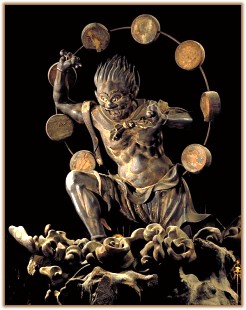
Raijin (God of Thunder)
Surrounded by drums, holds hammer to beat drums
13th century, wood, Sanjūsangendō in Kyoto
Scanned from temple brochure
|

Fūjin / Fujin (God of Wind)
13th century, wood, Sanjūsangendō in Kyoto
Scanned from temple brochure
|
|
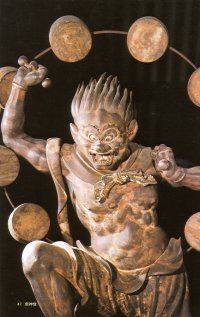 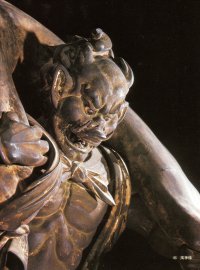
L: Raijin (Thunder God) R: Fūjin (Wind God)
Same images as above. Click images for larger photos.

Below Text Courtesy of:
Japanese Legendary Lives by Gen-ichi NISHIO
Fujin is the god of wind, and Raijin is a the god of thunder, who are depicted in Chinese legends. Both are thought to live above the clouds. Fujin is usually depicted as a muscled man with a big cloth sack, which is filled with numerous winds. When he opens his sack, a blast of wind escapes.
Raijin (or Raiden) is usually depicted as a muscled man with a series of drums around him, with which he made the rumbling of thunder. Raijin looks like a Oni, and the two are often confused. A legend of Chinese Buddhism says that the two gods were originally evil demons who opposed Buddha. So Buddha ordered his heavenly army to capture the two demons. After a severe battle between demons and 33 gods, the two demons were finally captured. They have been working for heaven ever since. Raijin (or Raiden) got his name from the two Japanese words rai for thunder and den for lightening. According to the Japanese legend he saved Japan from a fleet of invading Mongolians in 1274 AD. The way he managed it was to sit on a cloud, throwing a shower of lightening arrows against the Mongolian fleet. As the god of thunder, Raiden is shown with a drum.
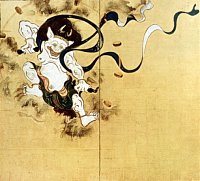 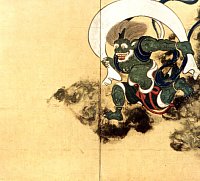
Artist Tawaraya Sotatsu (about 1600-1640 AD)
Thunder and Wind Gods, Screen, Important Cultural Property
Gold leaf and ink on paper; section of a folding screen
Edo Period (1615 - 1868)
Located at Kennin-ji in Kyoto
Click images for larger photos.
Says Akiyama Terukazu: Expression becomes freer and more dynamic in the pair of screen paintings representing the Wind God and the Thunder God, in the Kennin-ji at Kyoto. By assimilating the classical iconography of these divinities and taking inspiration from the polychrome statues erected in the early 13th century in the sanctuary of the Renge-o-in, and more particularly from the lightning god in the illuminated scroll of Kitano-tenjin-engi, Sotatsu succeeds in reconciling energy of movement with a decorative effect. This composition, often copied by his successors, marks one of the culminating points of his art. One of the few facts we know for certain of Sotatsu's life is that in the autumn of 1630, having already acquired the dignity of hokkyo (third in rank of the honorary titles of Buddhist monks, which could also be granted to lay artists), he copied four illuminated scrolls of the Saigyo-hoshi-ekotoba (Life of the Poet-Monk Saigyo).
 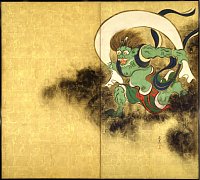
Artist Ogata Korin (1658-1716 AD)
Thunder and Wind Gods, Screen, Important Cultural Property
Photo and Text Courtesy of Tokyo National Museum.
Click images for larger photos.
Both the Wind God and the Thunder God are originally subordinates to the Senju Kannon, and worshipped together with Kannon’s 28 attendants. This is a copy of Sotatsu's crowning work by Korin(see above photos). While Sotatsu's original picture is characterized by a broad gold space and a composition with a strong feeling of tension, where the Wind God and the Thunder God face each other from both ends, Korin showed a difference in creative sense by stabilizing the composition by placing the two gods at the center and trying to depict the figures of the two gods clearly with bright primary colors. <end quote from Akiyama>
For more on the Sotatsu - Korin School of painting (17th to 19th Century), please see the review by Akiyama Terukazu. Also see a slide show of many works by Sotatsu and Korin by clicking here.

Fūjin 風神 and Raijin 雷神
Full JAANUS Entry: Lit. Wind God and Thunder God. Based on popular Indian deities (Sk: Vayu and Varun) and Chinese dieties (Fengshe 風神 and Leigong 雷公). Although the deities have no basis in early Buddhist scripture, the pair were added to the Twenty-Eight Attendants (Nijuuhachibushuu 二十八部衆), forming part of the retinue of the One-thousand Armed Kannon (Senju Kannon 千手観音). In esoteric Buddhism (mikkyou 密教), the Wind God is included among the Twelve Devas (Juuniten 十二天) as Fuuten 風天 and among the Gods of the Realms and Eight Directions (Gosei happouten 護世八方天) as the guardian of the northwest. He is also associated with the constellation Sagittarius (Jp: Iteza 射手座). The Wind God holds a large drawstring bag over his shoulder, from which he releases wind. Sometimes he grasps a spear with a red pennant. In Japan the Wind God is usually depicted as a green demon with two horns, a grimacing mouth, and claw-like feet and hands. The Thunder God, typically, is red with a horned demon head, simian mouth, and claw-like feet and hands. He is encircled by a ring of drums, and often a small hammer to beat them. In China, the earliest known representations of the Wind and Thunder Gods are found in the 6c caves at Dunhuang 敦煌 (Jp: Tonkou, where they are accompanied by rain and lightning gods. The Wind and Thunder Gods later appeared in 12c woodblock printed books depicting One-thousand Armed Kannon and the Twenty-Eight Attendants. The earliest depiction in Japan is in an illustration of the "Sutra of Past and Present Cause and Effect" (KAKO GENZAI INGAKYOU 過去現在因果経, 8c), in which the Wind and Thunder Gods are included among demons attempting to frighten the Historic Buddha. The two deities appear in several Heian period mandara 曼荼羅, such as in the "Konkoumyou Saishououkyou Mandara" 金光明最勝王経曼荼羅 (12c). The 13c Kei school (Keiha 慶派) sculptures at the Sanjuusangendou 三十三間堂, Kyoto, represent the development of a sculptural tradition. Many legends and folk-tales surround the Thunder God and he is included in various illustrated narrative handscrolls (emaki 絵巻). For instance, according to the Kitano tenjin-engi 北野天神縁起 ("Legends of Kitano Shrine"), the vengeful spirit of Sugawara Michizane 菅原道真 (845-903) took the form of the Thunder God, and this illustration became one of the highlights of various versions of scrolls. The Edo period folding-screen (byoubu 屏風) paintings of the Wind and Thunder Gods by Soutatsu 宗達 (?-ca. 1640, Kenninji 建仁寺, Kyoto) and Ogata Kourin 尾形光琳 (1658-1716, Tokyo National Museum) are well known. <end JAANUS quote>
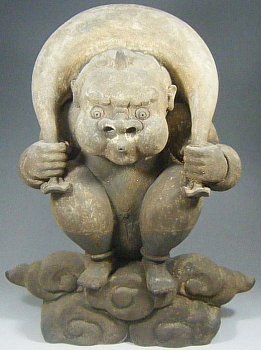 
Stoneware statues of the Wind God and Thunder God by acclaimed Japanese
ceramist Koinuma Michio. Fūjin = 42.5 cm.in height, Raijin 41 cm in height.
In a past issue of Japan's leading ceramic magazine Honoho Geijutsu, Koinuma Michio was named one the top 100 potters in Japan (see the complete list at e-yakimono.net). That is quite an honor considering the tens of thousands of professional potters here. Koinuma (1936 -) is based in Mashiko but his creations are far from Mingei; they are clay works of highest artistic merit; another past issue of HG (Issue 21, 1988) had a feature called 'The Appearance of the Next Generation' that focused on five ceramic artists, those being Kaneko Jun, Takagi Seirei, Morino Taimei, Wada Morihiro and Koinuma. Koinuma has essayed some amazing work --shown worldwide, some based on ancient bronzes and Haniwa figures and some totally his own. Click here for Koinuma’s bio.

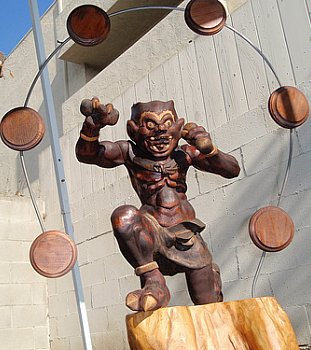 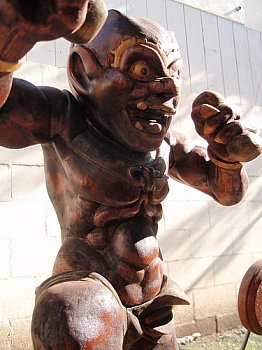
Modern Wooden Statue of Raijin by LA-based artist David Bilbrey.
About two feet tall, made from five blocks of basswood.
The statue was heavily inspired by David’s first visit to Sanjūsangendō (Kyoto).
See more photos at David’s site.
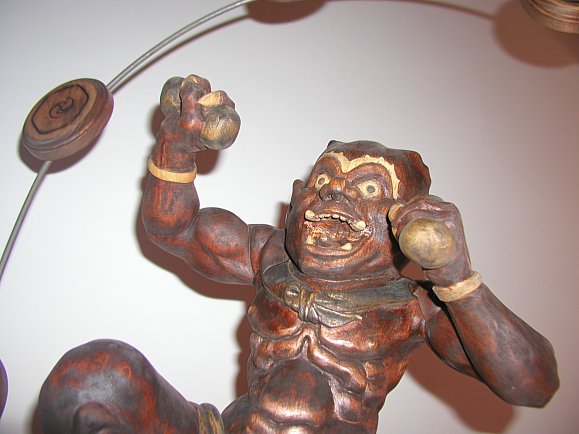
Modern Wooden Statue of Raijin by LA-based artist David Bilbrey.
About two feet tall, made from five blocks of basswood.
Drums were later branded with the futatsudomoe 二つ巴 (double tomoe).
See more photos at David’s site.

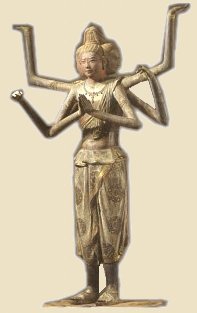
Ashura, Wood, Nara Era, Kyofuku-ji Temple
Photo: Handbook on Viewing Buddhist Statues. Click here to buy J-book at Amazon.

|